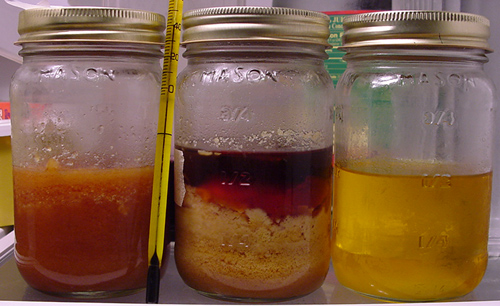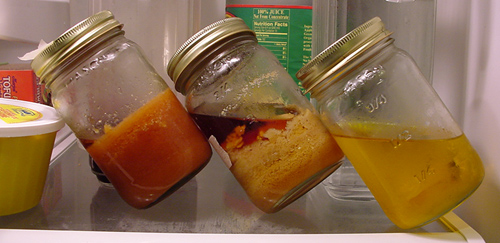| "Virgin," "Extra Virgin," "Cold Pressed,"
"Expeller Pressed," "Saturated," "Monounsaturated,"
"Polyunsaturated," "Hydrogenated," etc... Are you confused
yet? Let's examine these terms for any traces of meaning, particularly as
they relate to biodiesel production.
There are three primary methods for producing vegetable oils today:
1. The Hydraulic Press is the "oldest" method, uses the lowest
technology, and produces arguably the best quality oil for human consumption.
Like squeezing water from a mop, the hydraulic press compresses either
cold or heated batches of seeds or vegetables into a smaller and smaller
space, forcing their oil to escape through a screen or filter and leaving
the dry pulp behind.
2. The Expeller Press uses a continuous process in which cooked vegetable
material enters one end of a rotating screw mechanism that forces the
material into tighter and tighter spaces, with oil escaping along the
way until the dry pulp is finally ejected at the other end of the screw.
3. Solvent Extraction is the newest, highest technology, and most efficient
of the three processes. Vegetable material is ground, cooked, and mixed
with petroleum-based solvents to extract the oil, leaving a dry pulp.
|
|
"Cold Pressed" typically refers to oil extracted by hydraulic
press without adding heat to the vegetable material. Olive and sesame
are the primary oils that can be extracted by cold pressing. Unfortunately,
"cold pressed" has no legal definition, and is therefore subject
to some creative marketing shenanigans.
Most "pressed" vegetable oils, whether extracted by hydraulic
press or expeller press, are heated, rather than cold pressed, allowing
more oil to be extracted.
"Virgin" and "Extra Virgin" typically
refer to the first hydraulic pressing of olive oil (multiple pressings
are typically used to get additional oil). These terms also have no legal
definitions, so buyer beware.
The typical marketing strategy for solvent extracted oil is not to mention
how it was extracted!
While the differences between these extraction techniques may be very
important for oils consumed by humans, diesel engines are not so particular
about how the vegetable oil was obtained. Biodiesel fuel from oil extracted
by any of these methods will burn equally well in your diesel engine with
one exception: In cold climates, biodiesel may gel, preventing it from
passing freely from fuel tank to combustion chamber. To learn more about
this problem, we need to investigate a chemical property of oil know as
"saturation."
First, it may be useful to note that the only difference between an oil
and a fat is its melting temperature (or freezing temperature or "gel
point" - all the same temperature, just different ways to look at
it). Vegetable and animal oils and fats are classified as Saturated or
Unsaturated. Saturated fats (such as lard) have higher gel points, and
are typically solid at room temperature. Unsaturated oils are further
divided into Monounsaturated and Polyunsaturated. These terms refer to
the number of double-bonds in the fatty acid hydrocarbon chains which
make up the oil. Monounsaturated oils such as olive have one double-bond
per hydrocarbon chain, while polyunsaturated oils such as canola have
multiple double-bonds.
|
|
Hydrogenation is a process by which hydrogen atoms are added to unsaturated
oils, converting them to saturated oils. The double bonds in unsaturated
oil hydrocarbon chains are easily broken and converted to a single bond
plus the attachment points for two additional hydrogen atoms. This process
happens any time you use vegetable oil to cook foods that contain some
water. That's one reason why fresh vegetable oil makes better biodiesel
fuel than waste vegetable oil, at least for use in colder climates. Typically,
the longer vegetable oil is used for cooking, the more saturated it becomes.
Biodiesel made from saturated oils (whether they came from animal sources
or from hydrogenated vegetable sources) gels at higher temperatures than
biodiesel made from unsaturated oils. When the weather is hot, it doesn't
matter whether your biodiesel gels at 40ºF or 30ºF, but even
here in central Florida, there are winter days when biodiesel that gels
at 40ºF will stop your car in its tracks.
In addition to "gel point," another characteristic of concern
to biodiesel users is "cloud point." This is the temperature
at which the biodiesel begins to get "cloudy." The biodiesel
remains liquid at this temperature, but suspended solids can clog fuel
filters, potentially causing your engine to stop.
The photos below show some biodiesel samples that have been chilled to
about 38ºF. You can see the extent to which each sample has gelled
or clouded at this temperature.
|
Biodiesel samples @ 38ºF
Three commercially-produced biodiesel samples at 38ºF on 26
December 2004
|
Left
From a Florida distributor in July 2004 - Mostly solid |
Middle sample
From same Florida distributor in November 2004 - About 60% solid |
Right sample
From a North Carolina distributor in September 2004 - Still liquid,
but "cloudy" |
|

Although condensation on the jar makes it hard to see, there is
a small layer
of "cloudy" stuff in the right-hand jar. Also notice the
small dark liquid layer that barely survives in the corner of the
left-hand jar.
|
|